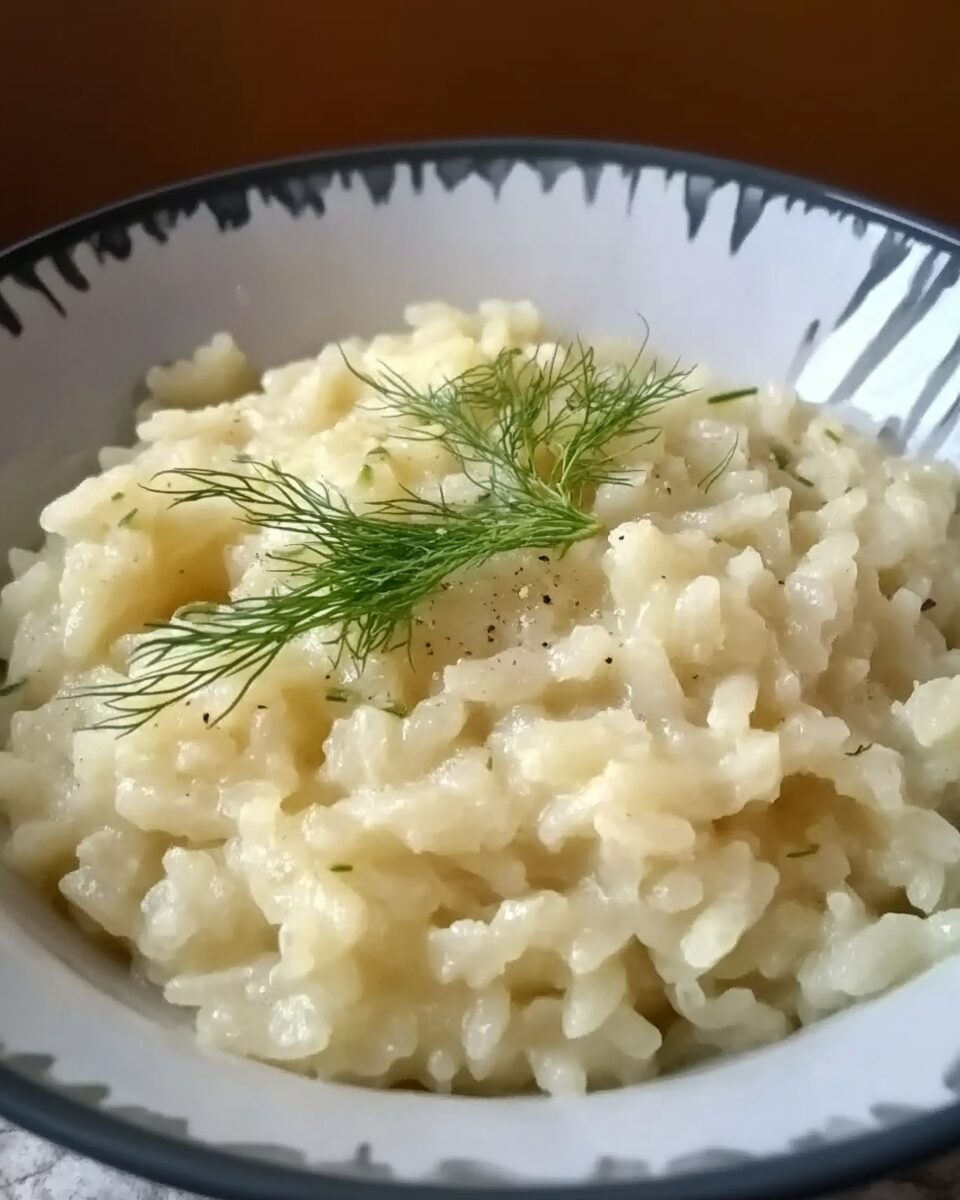Fennel risotto is a rich and creamy Italian dish that features the subtle, sweet flavor of fennel. The strong taste of fennel mellows after cooking, blending harmoniously with Arborio rice, cream, and Parmesan cheese to create a comforting meal.
Full Recipe:
Ingredients
- 4 bulbs fennel
- 1 tablespoon unsalted butter
- 1 medium onion, chopped
- 2 cups uncooked Arborio rice
- 7 cups vegetable broth
- 1 cup heavy cream
- 6 tablespoons freshly grated Parmesan cheese, divided
- 1 tablespoon dried parsley
- Freshly ground black pepper to taste
Directions
- Cut the base off the fennel bulbs and remove the cores by cutting a cone shape into the bases. Slice the fennel bulbs vertically into 1/4-inch thick slices.
- Melt butter in a heavy-bottomed stockpot over medium heat. Add fennel and onion; cook for 2 minutes. Stir in rice; cook for an additional 2 minutes, stirring constantly, until the rice is lightly toasted.
- Stir in 1 cup of vegetable broth; continue stirring until the liquid is almost completely absorbed. Repeat this process with the remaining broth, stirring constantly. Incorporating all the broth should take 15 to 20 minutes.
- Stir in cream, 3 tablespoons of Parmesan cheese, and parsley; cook until the rice is tender yet firm to the bite, and the risotto is thick and creamy. Season with freshly ground black pepper.
- Divide the risotto among serving bowls; sprinkle each with the remaining 3 tablespoons of Parmesan cheese.
Nutritional Facts (per serving)
- Calories: 537
- Total Fat: 19g
- Saturated Fat: 11g
- Cholesterol: 64mg
- Sodium: 725mg
- Total Carbohydrates: 81g
- Dietary Fiber: 7g
- Total Sugars: 5g
- Protein: 11g
- Vitamin C: 21mg
- Calcium: 190mg
- Iron: 3mg
- Potassium: 720mg
The Allure of Fennel in Cooking
Fennel, with its bulbous white base, feathery fronds, and delicate licorice-like aroma, is a versatile ingredient in Mediterranean cuisine. In its raw form, fennel adds crunch and brightness to salads. Once cooked, however, it transforms dramatically—its flavor mellows and deepens, taking on a sweetness that is both subtle and aromatic.
In fennel risotto, this transformation is key. Sautéed fennel softens and blends seamlessly into the creamy texture of risotto, infusing each bite with warmth and depth. This dish is a celebration of fennel’s ability to evolve through cooking, highlighting the vegetable’s full range of culinary potential.
Why Risotto?
Risotto is more than just rice—it’s a method of cooking that prioritizes texture, patience, and attention. Unlike boiled or steamed rice, risotto involves a gradual addition of broth to the rice while stirring constantly, releasing starches that create its signature creamy consistency.
Choosing risotto as the foundation for fennel ensures that the final dish is rich, luscious, and deeply comforting. Arborio rice, the most common variety used in risotto, is ideal because of its high starch content and ability to maintain a firm bite while absorbing flavor.
What sets fennel risotto apart from other risottos is its layered flavor profile. Where mushroom risotto leans earthy and seafood risotto leans briny, fennel risotto is delicate and slightly sweet, with a creamy texture that’s both luxurious and soothing.
A Vegetarian Main Course With Depth
One of the challenges in vegetarian cuisine is creating a main dish that feels substantial without the inclusion of meat. Fennel risotto meets this challenge beautifully. It offers richness from cream and Parmesan cheese, depth from slow-cooked vegetables, and satisfying texture from Arborio rice.
It’s a perfect dish for those looking to reduce their meat consumption or entertain guests with varying dietary preferences. It also pairs exceptionally well with plant-based sides like roasted Brussels sprouts, grilled asparagus, or a citrusy arugula salad.
A Dish That Invites Creativity
Fennel risotto provides a fantastic canvas for culinary creativity. Cooks can enhance the dish by incorporating other ingredients that complement fennel’s sweet undertones, such as leeks, lemon zest, saffron, or white wine. For a more decadent version, a drizzle of truffle oil or a sprinkle of toasted pine nuts can elevate the dish to fine-dining levels.
While the basic version keeps things simple with fennel, onion, cream, and Parmesan, it’s easy to make this dish your own. It’s also seasonally adaptable—serve it with bright herbs like dill or parsley in spring, or add roasted squash or mushrooms in the fall.
Perfect Pairings
When serving fennel risotto, consider how side dishes and beverages can complement its delicate flavor. Light vegetable sides and crisp green salads are natural companions. For beverages, a crisp white wine such as Pinot Grigio or Sauvignon Blanc balances the richness of the risotto with acidity and freshness.
For a more indulgent meal, pair fennel risotto with roasted chicken, seared scallops, or grilled shrimp. These proteins won’t overpower the subtle flavor of the risotto, but rather add a satisfying counterpoint.
Cultural and Regional Influence
Risotto is deeply ingrained in Italian culinary tradition, especially in regions like Lombardy and Veneto where rice cultivation has thrived for centuries. These regions have perfected the technique of risotto, turning it into a cherished staple.
The inclusion of fennel reflects the broader Mediterranean influence, where fennel grows abundantly and is celebrated for both its culinary and medicinal properties. In this context, fennel risotto represents the intersection of Italian culinary artistry and regional ingredients.
This dish tells a story of both tradition and evolution—how classic techniques can be paired with fresh, seasonal produce to create something timeless yet new.
Nutritional Insights
Fennel risotto not only delights the palate but also offers several nutritional benefits. Fennel is rich in vitamin C, potassium, and dietary fiber. It’s known for aiding digestion and providing antioxidant properties.
Though risotto is often perceived as indulgent due to its creamy texture, when made with vegetable broth and moderated use of cream and cheese, it can be a balanced, nourishing dish. The use of Arborio rice provides carbohydrates for energy, while additions like fennel and onion bring vitamins and minerals to the plate.
Vegetarians, in particular, may appreciate the combination of protein from the cheese and fiber from the vegetables, creating a wholesome meal in one bowl.
Making Risotto Less Intimidating
Many home cooks shy away from making risotto due to its reputation for being labor-intensive. While it’s true that risotto requires more attention than a typical rice dish, it’s not nearly as difficult as it’s made out to be.
The key lies in patience and rhythm—adding warm broth a ladleful at a time, stirring consistently, and trusting your senses. Watching the rice transform from hard grains to creamy softness is a rewarding experience. And the result is well worth the effort.
With a little practice, fennel risotto can become a go-to dish that impresses guests and nourishes family.
Seasonality and Serving Occasions
Fennel risotto is highly versatile when it comes to seasonality. In spring, it feels light and fresh. In fall and winter, its warmth and creaminess make it the perfect comfort food. It’s suitable for both casual weeknight dinners and formal occasions like holiday meals or dinner parties.
Its pale color and refined texture also make it a visually appealing dish that presents well on the plate, especially when garnished with fresh herbs or a sprinkling of cheese.
Storage and Reheating Tips
Leftover risotto can be stored in the refrigerator for up to 3 days. While risotto is best served fresh, it reheats reasonably well if done properly. Add a splash of broth or water to loosen it, and reheat gently on the stove over low heat while stirring.
Leftover risotto can also be transformed into arancini—crispy risotto balls coated in breadcrumbs and fried until golden. This is a classic Italian method of repurposing risotto, and it gives new life to any extras you may have.
Sustainability and Ingredient Accessibility
Fennel is widely available in most grocery stores and is often reasonably priced, making this dish accessible to a broad audience. Additionally, because it uses pantry staples like rice, broth, and onions, fennel risotto is budget-friendly without sacrificing quality or elegance.
Vegetable-based dishes like this one also have a lower environmental footprint than meat-heavy meals, making fennel risotto a sustainable choice for eco-conscious eaters.
Conclusion
Fennel risotto is more than just a delicious meal—it’s a celebration of culinary tradition, seasonal produce, and the joy of cooking with care. It brings together the transformative power of slow-cooked fennel with the timeless comfort of risotto, resulting in a dish that feels both rustic and refined.






